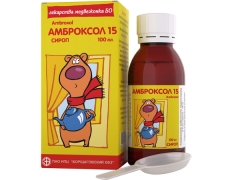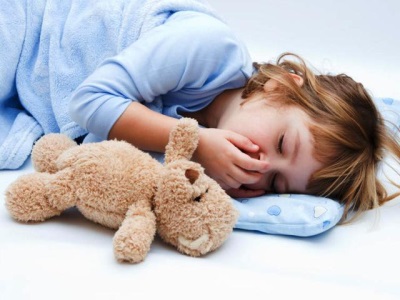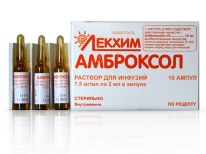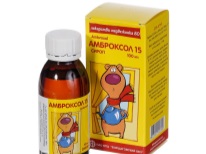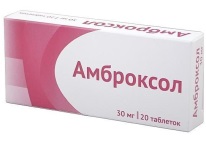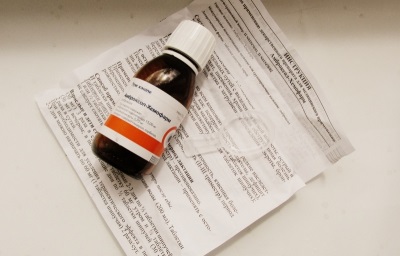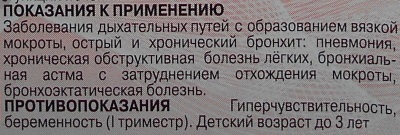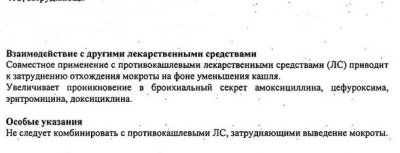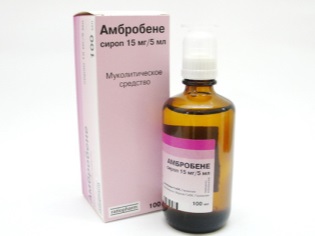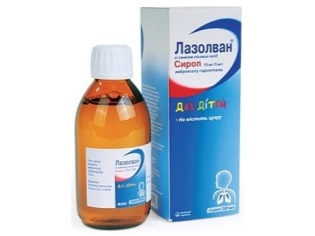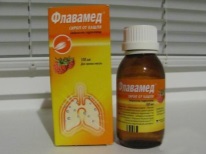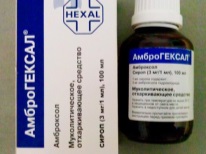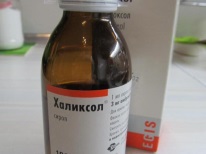Ambroxol: instructions for use for children
When a child suffers from a cough, doctors recommend effective expectorant drugs, among which Ambroxol can be called. Is it possible to give this medicine at an early age, than it can harm the children's body and how to take it correctly?
Release form
Ambroxol is produced in the following forms:
- Syrup. It is represented by a slightly viscous transparent liquid of yellowish tint or without color. The taste and smell of syrup can be banana, apricot, raspberry or fruit. The content of the active substance in 5 ml of such a sweet suspension can be either 15 mg or 30 mg. One pack of medicine contains 50, 100, 125 or 150 ml of syrup, as well as a measuring spoon or a measuring cup.
- Solution, which is used for inhalation or used inside. One milliliter of such a clear, colorless or brown medicine contains 7.5 mg of the active ingredient. The package contains 40 or 100 ml of liquid, as well as a measuring cup.
- Injection. It is a sterile liquid packaged in 2 ml ampoules, which can be injected either intramuscularly or into a vein. One ampoule contains 15 mg of active substance (7.5 mg of ambroxol per 1 ml of solution).
- Pills. Each of these white round or cylindrical tablets contains 30 mg of the active ingredient. One pack may contain from 10 to 100 tablets, packaged in blisters of 10 or 20 pieces.
Composition
The active substance in any form of Ambroxol is represented by the compound “Ambroxol Hydrochloride”. The syrup contains additional substances such as water, flavors, benzoic acid, glycerol, citric acid, sodium saccharinate and other ingredients.
In addition to ambroxol, tablets contain lactose, starch from potatoes, talc, silica and calcium or magnesium stearate. In the solution for oral administration there is not only Ambroxol and water, but also citric acid, benzalkonium chloride, sodium chloride, and sodium hydrogen phosphate.
Operating principle
Since Ambroxol affects the production of mucus in the bronchial tree, this medicine is classified as secretolytic (mucolytic). After ingestion of the patient, the drug is almost completely absorbed and transferred to the lung tissue. There, its active substance activates the production of sputum glycoproteins and changes the structure of polysaccharides. As a result, the secret becomes more fluid, which makes coughing easier.
In addition, Ambroxol has the ability to stimulate the motor activity of the respiratory tract. The drug affects the ciliated epithelium, the result of which will be a more active movement of the cilia of these cells. This effect helps the expectorant action of the drug. In addition, in the alveoli, Ambroxol prevents the decomposition of surfactant, and also improves its production.
At what age is it allowed to take?
Ambroxol use in pediatrics is permissible from birth. When indicated, such a drug is prescribed even to newborns, including babies, whose birth occurred earlier than the required time. In this case, Ambroxol treatment at the age of up to one year must be under the supervision of a specialist. A tablet form is started from the age of 6, when a child can swallow a pill without any difficulty.
Indications
Appointment of Ambroxol to a child is justified with a wet cough, if the sputum produced in the respiratory tract has a high viscosity, which prevents the child from coughing up.
This situation occurs:
- With acute bronchitis.
- With pneumonia.
- With chronic pulmonary pathologies occurring with obstruction.
- With asthma.
- When identified in the respiratory tract bronchiectasis.
Newborn Ambroxol is indicated for respiratory distress, which is called distress. Also, this medicine is often prescribed for cystic fibrosis.
Contraindications
Reception of Ambroxol is prohibited in case of hypersensitivity to its active substance or to other components, for example, lactose in the composition of the tablets.
This medicine is also not recommended:
- With convulsive syndrome.
- At high risk of stagnation of mucus in the respiratory tract (if the motility of the bronchi is broken or the secret is formed in too large quantities).
- With ulcerative pathology of the digestive tract.
- When liver failure.
- With serious kidney disease.
Instructions for use of syrup for children warns about the caution of treatment with such Ambroxol for problems with carbohydrate metabolism.
Side effects
- The digestive system of the child may respond to Ambroxol intake by diluting the stool or, conversely, constipation. If the drug is used for a very long time, it provokes nausea, abdominal pain, heartburn and even vomiting.
- Another common side effect of Ambroxol is allergy, which can be provoked by flavoring agents and other chemicals. While taking the medicine, the child may complain of an itchy rash or swelling of the skin. Occasionally, the drug causes dermatitis, and in some children, the first dose of Ambroxol leads to anaphylactic shock.
- Rarely, the children's body responds to Ambroxol treatment with headaches, drying up of the mucous membrane of the oropharynx, weakness, dysuric phenomena, nasal discharge.
- In some children, Ambroxol leads to increased nervous excitability.
- If the drug is injected into the vein too quickly, it will lead to severe headache, shortness of breath, increased body temperature, chills, numbness and low blood pressure.
Instructions for use and dosage
A single dose of Ambroxol, as well as the frequency of taking the medicine is determined taking into account the age of the child:
- For babies under 5 years old, for example, at 4 years old, the drug is given in 7.5 mg of active substance. This corresponds to 1 ml of oral solution, half a measuring spoon of syrup with ambroxol content of 15 mg / 5 ml or 1/4 measuring spoon of syrup with a higher concentration (30 mg / 5 ml).
- For children aged 6-12 years, the dosage of Ambroxol at a time is 15 mg. If it is necessary to give a solution inside, then measure 2 ml of liquid. Syrup with an active ingredient concentration of 15mg / 5ml gives 1 scoop (5 ml), and a more concentrated syrup (30mg / 5 ml) - half a spoon (2.5 ml).
- For children over 12 years old, a single dose of the drug is 30 mg of the active substance. This is a whole tablet, 4 ml of solution, 10 ml of syrup with a concentration of 15 mg / 5 ml (two full measuring spoons) or 5 ml of syrup with ambroxol content of 30 mg / 5 ml (one spoon).
The medicine is given after meals to protect the digestive tract from irritation. Ambroxol should be prescribed by a doctor to children of the first two years of life, and the frequency of taking syrup or solution is 2 times a day. At the age of two to 5 years, the drug is given in the same dose, but already three times a day.
Children 6 years and older are offered medicine twice or thrice a day. Very often in the first few days the frequency of taking Ambroxol will be higher (3 times), and then reduced to 2 times. The duration of the drug in each case is set individually.
Inhalations with Ambroxol do 1-2 times a day through a nebulizer, mixing liquid medicine with saline in equal proportions.They are recommended from 5 years of age at a dosage of 15 to 22.5 mg of ambroxol per procedure (2-3 ml solution for inhalation). Children under 5 years of age can use 1-2 ml of ambroxol in solution (7.5-15 mg) as prescribed by a doctor for inhalation.
Injecting Ambroxol in newborns provides for a daily dosage of 10-30 mg of the active substance per kilogram of body weight. Drug administration is performed 3-4 times a day. The drug can be administered drip, diluting with saline or dextrose.
The daily dose of the drug for intravenous administration at the age of 1 month to 2 years is 15 mg (1 ampoule), at the age of 2-5 years - 22.5 mg (1.5 ampoules), and for children over 5 years old - from 30 to 45 mg (2-3 ampoules). For babies up to the age of two, this dose is divided into two injections, and for children over 2 years old, it is permissible to divide the daily dosage into three injections.
Overdose
An excessively high dose of Ambroxol increases saliva secretion, provokes severe nausea, lowers blood pressure, or causes vomiting. To treat an overdose of an ingested medication, wash the stomach as quickly as possible, and then give the child foods rich in fats. Further, the patient's condition is important to carefully monitor and, if necessary, immediately seek medical help.
Interaction with other drugs
- If Ambroxol is prescribed along with antitussive medications that affect the cough reflex, it can provoke mucus congestion in the airways.
- Appointment with Ambroxol of some antibiotics (Erythromycin, Amoxicillin, Doxycycline, Cefuroxime) will promote greater penetration of antibacterial agents into the secret of the bronchi.
- The solution for injections can not be added to one syringe with medications, which have a pH above 6.3.
Terms of sale
You can buy any form of Ambroxol at the pharmacy without a prescription, but consultation with a doctor, if the drug is intended for a child, is desirable. The price of twenty tablets of Ambroxol ranges from 30 to 50 rubles, 40-60 rubles must be paid for a bottle of syrup, and 40 ml of Ambroxol solution costs an average of 80 rubles.
Storage conditions and shelf life
The medicine should not be freely available for a small child. Ambroxol storage temperature should not exceed +25 degrees Celsius. Place for tablets, syrup or solution should be chosen dry and away from direct sunlight. Do not store Ambroxol for longer than indicated in the shelf life of the drug on the package. For tablets, this period is 3 years, for syrup - 2 years.
Reviews
On the use of Ambroxol in the treatment of cough in children speak mostly well. Reviews of mothers emphasize the effectiveness of the drug and quick help to children with dry cough and problems with expectoration of sputum. The drug is in demand for bronchitis and other diseases of the respiratory system. Children tolerate it mostly well, and allergies or other side effects are rare.
Analogs
If the use of Ambroxol is not possible, the medicine can be changed to any other drug containing the same active ingredient.
A replacement can be such an analogue:
- Ambrobene. Such a German drug is represented by a wide variety of release forms. Among them are raspberry syrup, a solution that can be drunk, and tablets. The drug is also available in capsules with an extended period of action and in an injection form (ampoules with a solution for administration into a vein).
- Hemofarm. Such a Serbian Ambroxol is produced in the form of raspberry syrup and effervescent lemon tablets containing 30 or 60 mg of active substance.
- Lasolvan. This Greek medicine is one of the most sought after among Ambroxol analogues. The drug is produced in syrup with a concentration of the active ingredient in 5 ml of 15 mg or 30 mg. This medicine has the taste of strawberries or wild berries.Lasolvan is also represented by mint lozenges (containing 15 mg of ambroxol), 30 mg tablets of the active substance and a solution that can be drunk or used for inhalation.
- Ambrohexal. This medicine is produced in Germany in the form of a solution (dosed in drops), capsules, tablets and raspberry or apricot syrup.
- Halixol. This Hungarian medicine is represented by strawberry-banana syrup with ambroxol content of 30 mg in 10 ml, as well as tablets.
- Ambrosan. Such a Czech drug is produced in tablets, as well as in the form of a solution with a concentration of the active substance of 7.5 mg per milliliter for oral administration.
- Flamed. This medicine from Germany is produced in tablets, as well as in solution, 5 ml of which contain 15 mg of ambroxol.
- Bronchus. This domestic Ambroxol analogue is represented by raspberry syrup (3 ml of the active substance in each ml) and tablets.
- Medox. This Slovak drug is available both in tablets and in the form of honey syrup containing 15 mg of ambroxol per 5 ml of the drug.
